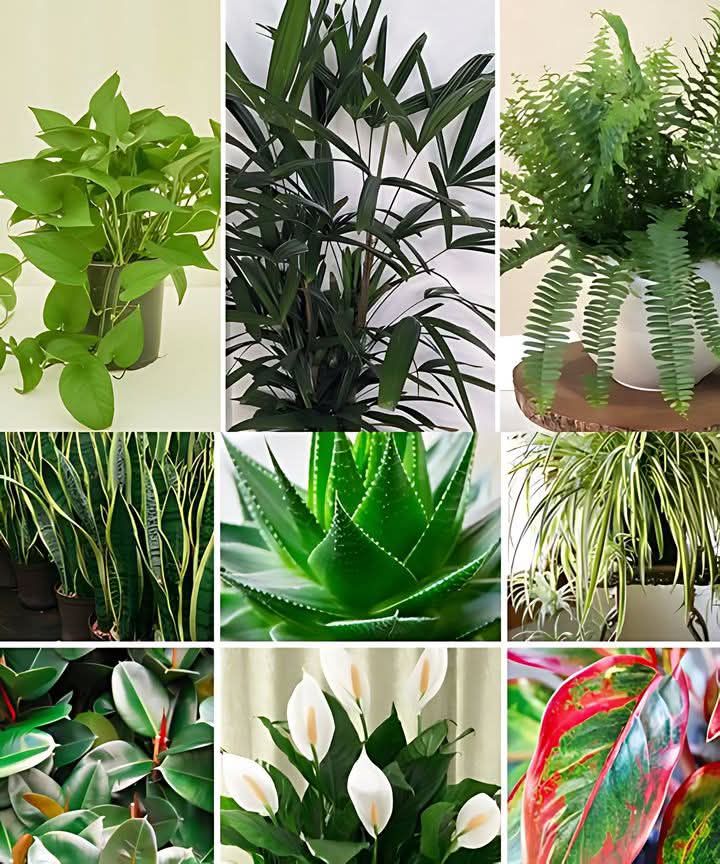9 Plants That Purify the Air in Your Home and Eliminate Bad Odors
Indoor plants not only add beauty and life to your home, but they also play a vital role in improving air quality and eliminating unpleasant odors. Certain plants are especially adept at filtering toxins and releasing fresh oxygen, making them ideal for maintaining a clean and healthy indoor environment. Here are 9 plants you should consider adding to your home for natural air purification and odor elimination.
1. Peace Lily (Spathiphyllum)
- Benefits: Peace lilies are excellent at removing harmful toxins like benzene, carbon monoxide, and formaldehyde. They also neutralize unpleasant odors.
- Care: Thrive in low to medium light conditions and require moderate watering. Avoid overwatering to prevent root rot.
- Placement: Perfect for bathrooms, bedrooms, or kitchens where air circulation may be limited.
2. Snake Plant (Sansevieria trifasciata)
- Benefits: Known as the “mother-in-law’s tongue,” this hardy plant releases oxygen at night and filters out toxins such as formaldehyde and xylene, making it perfect for freshening up any space.
- Care: Requires minimal care; place it in bright, indirect light and water sparingly.
- Placement: Ideal for bedrooms and living areas due to its air-purifying abilities.
3. Aloe Vera (Aloe barbadensis miller)
- Benefits: Aloe vera not only purifies the air but also absorbs carbon dioxide and eliminates benzene and formaldehyde, common in household products.
- Care: Prefers bright, indirect sunlight and well-draining soil. Water sparingly, allowing the soil to dry between watering.
- Placement: Great for sunny kitchen windows or living rooms.
4. Spider Plant (Chlorophytum comosum)
- Benefits: Spider plants are excellent at removing carbon monoxide, formaldehyde, and other pollutants. They also absorb unpleasant odors.
- Care: Low-maintenance; thrives in indirect sunlight and tolerates occasional neglect in watering.
- Placement: Perfect for kitchens, bathrooms, or any room with poor ventilation.
5. Bamboo Palm (Chamaedorea seifrizii)
- Benefits: This lush palm acts as a natural humidifier, improving air quality and reducing bad odors by absorbing airborne toxins like benzene and carbon monoxide.
- Care: Requires indirect light and moist soil, making it easy to maintain.
- Placement: Ideal for living rooms and offices where humidity and air purification are needed.
6. English Ivy (Hedera helix)
- Benefits: English ivy is a champion at absorbing toxins, including mold spores and fecal particles, which can cause odors in poorly ventilated areas.
- Care: Prefers moderate light and evenly moist soil. Trim regularly to prevent overgrowth.
- Placement: Excellent for bathrooms, kitchens, and areas prone to mildew or odors.
7. Rubber Plant (Ficus elastica)
- Benefits: Rubber plants are effective at removing toxins and improving indoor air quality. They also have large leaves that trap dust and other particles.
- Care: Prefers bright, indirect light and occasional watering.
- Placement: Perfect for living rooms or hallways, adding a bold, natural element while purifying the air.
8. Boston Fern (Nephrolepis exaltata)
- Benefits: This fern is highly efficient at increasing humidity, filtering toxins, and eliminating odors.
- Care: Thrives in high humidity and indirect light. Keep the soil consistently moist.
- Placement: Ideal for bathrooms, where it can thrive in the natural humidity and keep the air fresh.
9. Lavender (Lavandula)
- Benefits: Lavender not only purifies the air but also adds a calming scent, helping to eliminate bad odors and reduce stress.
- Care: Prefers bright, direct sunlight and well-draining soil. Water sparingly.
- Placement: Best suited for bedrooms or living rooms, where its soothing fragrance can create a relaxing atmosphere.
Tips for Maintaining Healthy Indoor Plants
- Proper Lighting: Ensure each plant receives the recommended amount of light for optimal growth.
- Watering: Overwatering is a common issue. Check the soil moisture before watering.
- Cleaning: Wipe leaves regularly to remove dust and maximize the plant’s air-purifying abilities.
- Rotate Plants: Rotate pots every few weeks to ensure even growth and exposure to light.
Conclusion
Incorporating these air-purifying plants into your home not only enhances the aesthetic appeal of your space but also contributes to a healthier indoor environment. These plants work naturally to eliminate toxins and odors, making your home fresher and more inviting. Whether placed in the kitchen, bathroom, or living room, these plants are a simple, eco-friendly way to improve air quality and combat unpleasant smells. Start growing these natural purifiers today for a greener, cleaner home! 🌿
